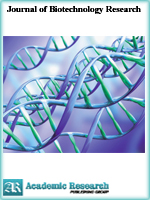Journal of Biotechnology Research
Online ISSN: 2413-3256
Print ISSN: 2413-8878
Print ISSN: 2413-8878
Quarterly Published (4 Issues Per Year)

Archives
Volume 2 Number 7 July 2016
The Effect of Nigella Sativa Lin. Black Seeds/Kalonji (Family Ranunculaceae) On Hyperglycemia, Dislipidemia and Serum Uric Acid in Human Diabetics
Authors: Saghir Ahmed Jafri ; Khaleeq Ur Rehman ; Muhammad Qasim ; Muhammad Shareef Masoud ; Abubakar Imran ; Muhammad Usman Siddiq
Pages: 55-58
Abstract
Objective: The objective of this study was to investigate the effect of Nigella sativa Lin. (Nigella sativa L.) on Serum Glucose, Cholesterol, Triglycerides and Uric Acid concentration (mg/dl) in patients suffering from Diabetes mellitus type 2 compared to normal) human beings. Methods: Nigella sativa was selected to estimate its effect on Serum Glucose, Cholesterol, Triglycerides and Uric Acid in diabetics and normal (control) human beings. Previous workers, fed 2gm/day Nigella sativa L. as crushed seed with meals. The present study continued for 42 days and serum samples were collected on Day 01, Day 28 and day 42. The above parameters were estimated by using enzymatic kits through spectrophotometry. Results: The results revealed significant decrease(P<0.05) in Serum Glucose, Cholesterol, Triglycerides and Uric Acid in diabetics on Day 28 and the decrease further increased on Day 42 as compared to Day 01, or with control individuals. The Nigella sativa Lin. did not show any significant effect on any of the above parameters in normal individuals. Conclusion: It can be concluded that Nigella sativa L. can be safely substituted allopathic treatment of diabetics to manage the disease with beneficial effect on its dislipidemic and uricemic complications.
Resistance Profiles of Bacteria Isolated from Wastewater in the University of Maiduguri Teaching Hospital
Authors: Adam Mustapha ; Isa Tijani ; H. S. Bello ; H. Y. Ismail
Pages: 49-54
Abstract
Antibiotics have always been considered one of the wonderful discoveries of the 20th century. Their use as effective antibacterial agents was however short-lived, as bacteria started developing resistance almost as soon as the agents were discovered. The worrisome growth of antibiotic resistance is blamed primarily on the misuse and overuse of the agents in human and agricultural settings. This study was carried out to identify common bacterial species in hospital wastewater and to determine their pattern of resistance to commonly used antibiotics. Grab samples were collected from the general wastewater channel of The University of Maiduguri Teaching Hospital, Maiduguri. The bacterial isolates identified were E. coli, S. enterica, P. aeruginosa, Proteus mirabilis, K. pneumoniae, V. cholerae, M. morganii, Proteus vulgaris and C. fruendii. Antibiotic susceptibility of the isolates was assayed using the Modified Kirby-Bauer disc diffusion method. Resistance was highest with Nalidixic Acid (100%) and lowest with Ciprofloxacin and Streptomycin (20% each). Others include Ceporex and Ampicillin (88% each), Tarivid, Gentamycin and Septrin (50% each), Reflacine (63%) and Augmentin (75%). Out of all the antibiotics used, E. coli showed 100% resistance whereas M. morganii was susceptible to all the antibiotics except Gentamycin and Erythromycin. It was found that, except for M. morganii, all the isolates were multi drug resistant suggesting that they have been well exposed to antibiotics and thus, developed multi resistance. This emphasizes the need for surveillance on trends in antibiotic resistance and development of alternative therapy to tackle antibiotic-resistant bacteria.



